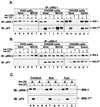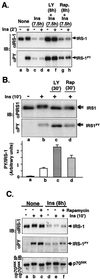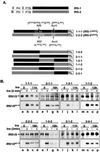Molecular mechanism of insulin-induced degradation of insulin receptor substrate 1
- PMID: 11809794
- PMCID: PMC134643
- DOI: 10.1128/MCB.22.4.1016-1026.2002
Molecular mechanism of insulin-induced degradation of insulin receptor substrate 1
Abstract
Insulin receptor substrate 1 (IRS-1) plays an important role in the insulin signaling cascade. In vitro and in vivo studies from many investigators have suggested that lowering of IRS-1 cellular levels may be a mechanism of disordered insulin action (so-called insulin resistance). We previously reported that the protein levels of IRS-1 were selectively regulated by a proteasome degradation pathway in CHO/IR/IRS-1 cells and 3T3-L1 adipocytes during prolonged insulin exposure, whereas IRS-2 was unaffected. We have now studied the signaling events that are involved in activation of the IRS-1 proteasome degradation pathway. Additionally, we have addressed structural elements in IRS-1 versus IRS-2 that are required for its specific proteasome degradation. Using ts20 cells, which express a temperature-sensitive mutant of ubiquitin-activating enzyme E1, ubiquitination of IRS-1 was shown to be a prerequisite for insulin-induced IRS-1 proteasome degradation. Using IRS-1/IRS-2 chimeric proteins, the N-terminal region of IRS-1 including the PH and PTB domains was identified as essential for targeting IRS-1 to the ubiquitin-proteasome degradation pathway. Activation of phosphatidylinositol 3-kinase is necessary but not sufficient for activating and sustaining the IRS-1 ubiquitin-proteasome degradation pathway. In contrast, activation of mTOR is not required for IRS-1 degradation in CHO/IR cells. Thus, our data provide insight into the molecular mechanism of insulin-induced activation of the IRS-1 ubiquitin-proteasome degradation pathway.
Figures








Similar articles
-
A rapamycin-sensitive pathway down-regulates insulin signaling via phosphorylation and proteasomal degradation of insulin receptor substrate-1.Mol Endocrinol. 2000 Jun;14(6):783-94. doi: 10.1210/mend.14.6.0446. Mol Endocrinol. 2000. PMID: 10847581
-
Mammalian target of rapamycin pathway regulates insulin signaling via subcellular redistribution of insulin receptor substrate 1 and integrates nutritional signals and metabolic signals of insulin.Mol Cell Biol. 2001 Aug;21(15):5050-62. doi: 10.1128/MCB.21.15.5050-5062.2001. Mol Cell Biol. 2001. PMID: 11438661 Free PMC article.
-
Regulation of insulin/insulin-like growth factor-1 signaling by proteasome-mediated degradation of insulin receptor substrate-2.J Biol Chem. 2001 Oct 26;276(43):40362-7. doi: 10.1074/jbc.M105332200. Epub 2001 Aug 23. J Biol Chem. 2001. PMID: 11546773
-
IRS-1 regulation in health and disease.IUBMB Life. 2003 Jul;55(7):367-74. doi: 10.1080/1521654031000138569. IUBMB Life. 2003. PMID: 14584587 Review.
-
Current Studies on Molecular Mechanisms of Insulin Resistance.J Diabetes Res. 2022 Dec 23;2022:1863429. doi: 10.1155/2022/1863429. eCollection 2022. J Diabetes Res. 2022. PMID: 36589630 Free PMC article. Review.
Cited by
-
Rapamycin does not improve insulin sensitivity despite elevated mammalian target of rapamycin complex 1 activity in muscles of ob/ob mice.Am J Physiol Regul Integr Comp Physiol. 2008 Nov;295(5):R1431-8. doi: 10.1152/ajpregu.90428.2008. Epub 2008 Sep 3. Am J Physiol Regul Integr Comp Physiol. 2008. PMID: 18768766 Free PMC article.
-
Disruption of glucose homeostasis and induction of insulin resistance by elevated free fatty acids in human L02 hepatocytes.J Endocrinol Invest. 2009 May;32(5):454-9. doi: 10.1007/BF03346485. Epub 2009 Apr 29. J Endocrinol Invest. 2009. PMID: 19494713
-
Protein phosphatase 4 (PP4) functions as a critical regulator in tumor necrosis factor (TNF)-α-induced hepatic insulin resistance.Sci Rep. 2015 Dec 15;5:18093. doi: 10.1038/srep18093. Sci Rep. 2015. PMID: 26666849 Free PMC article.
-
Current views on type 2 diabetes.J Endocrinol. 2010 Jan;204(1):1-11. doi: 10.1677/JOE-09-0260. Epub 2009 Sep 21. J Endocrinol. 2010. PMID: 19770178 Free PMC article. Review.
-
Glycogen synthase kinase 3 beta mediates high glucose-induced ubiquitination and proteasome degradation of insulin receptor substrate 1.J Endocrinol. 2010 Aug;206(2):171-81. doi: 10.1677/JOE-09-0456. Epub 2010 May 13. J Endocrinol. 2010. PMID: 20466847 Free PMC article.
References
-
- Anai, M., M. Funaki, T. Ogihara, J. Terasaki, K. Inukai, H. Katagiri, Y. Fukushima, Y. Yazaki, M. Kikuchi, Y. Oka, and T. Asano. 1998. Altered expression levels and impaired steps in the pathway to phosphatidylinositol 3-kinase activation via insulin receptor substrates 1 and 2 in Zucker fatty rats. Diabetes 47:13-23. - PubMed
-
- Araki, E., M. A. Lipes, M. E. Patti, J. C. Bruning, B. Haag, 3rd, R. S. Johnson, and C. R. Kahn. 1994. Alternative pathway of insulin signalling in mice with targeted disruption of the IRS-1 gene. Nature 372:186-190. - PubMed
-
- Backer, J. M., M. G. Myers, Jr., X. J. Sun, D. J. Chin, S. E. Shoelson, M. Miralpeix, and M. F. White. 1993. Association of IRS-1 with the insulin receptor and the phosphatidylinositol 3"-kinase. Formation of binary and ternary signaling complexes in intact cells. J. Biol. Chem. 268:8204-8212. - PubMed
Publication types
MeSH terms
Substances
Grants and funding
LinkOut - more resources
Full Text Sources
Other Literature Sources
Medical
Research Materials
Miscellaneous
